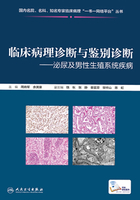
第八章 髓质海绵肾
【定义】
髓质海绵肾(medullar sponge kidney,MSK)是一种先天性发育异常,表现为肾髓质乳头部的集合管扩张,呈囊状。多数MSK为散发性,少数为遗传性。
【临床特征】
1.流行病学
(1)发病率:
发病率约为1/5 000~1/2 000,普通人群发病率小于0.5%,在复发性草酸钙结石患者中约占12%~20%。
(2)发病年龄:
多数在年轻成人患者中得到确诊,但常在出生时已经存在。
(3)性别:
男性多见。
2.症状
表现为复发性尿路结石及感染等并发症,并有肾绞痛,腰背部疼痛和间歇性血尿、脓尿等。
3.实验室检查
显示为尿路结石及尿路感染等并发症相关的异常。
4.影像学特点
超声显示双肾大小正常或略增大,可见围绕髓质呈放射状的无回声区和强回声光点,伴有后方声影;腹部平片显示多发性结石在肾乳头区呈簇状、放射状排列;尿路造影显示双肾乳头呈“画笔”样;CT平扫示双肾锥体内多发小结石,呈斑点状。
5.治疗
主要针对并发症,无症状和并发症时不需治疗。
6.预后
如反复并发尿路结石、尿路感染及肾盂肾炎时,可致肾功能受损,预后不良。
【病理变化】
1.大体特征
多为双侧肾脏受累。多数肾脏大体正常,约1/3患者肾脏弥漫性轻度增大。切面肾锥体见大小不等囊肿(多数直径<1.5mm),常伴小结石。
2.镜下特征
(1)组织学特征:
肾锥体囊肿内壁衬覆立方至柱状上皮,接近尿路上皮处可见上皮复层化;囊腔内含嗜伊红染物质,也可见磷酸盐结石/草酸钙结石、多核巨细胞、红细胞;间质可见纤维化及炎症细胞浸润;肾锥体外的肾实质内无囊肿形成。
(2)免疫组化:
肾锥体囊肿内衬上皮EMA阳性。
3.基因遗传学特征
约5%患者为常染色体显性遗传,可能与GDNF和RET基因突变或多态性相关。此外还可能与肾母细胞瘤、尿路发育异常、Beckwith-Wiedemann综合征、Rabson-Mendenhall综合征、先天性肝纤维化、Ehlers-Danlos综合征、MEN2及马凡氏综合征相关。
【鉴别诊断】
常染色体显性遗传多囊肾病(ADPKD)
可表现为肾盏周围肾小管扩张,但皮质囊肿和家族史的存在有助于区别MSK的散发性病例。
(王景美 付尧 樊祥山)
参考文献
[1]Davis TK,Hoshi M,Jain S.To bud or not to bud:the RET perspective in CAKUT.Pediatr Nephrol,2014,29(4):597-608.
[2]Hoshi M,Batourina E,Mendelsohn C,et al.Novel mechanisms of early upper and lower urinary tract patterning regulated by RetY1015 docking tyrosine in mice.Development,2012,139(13):2405-2415.
[3]Yosypiv IV.Congenitalanomalies of the kidney and urinary tract:a genetic disorder?Int J Nephrol,2012:909083.
[4]Song R,Yosypiv IV.Genetics of congenital anomaliesof the kidney and urinary tract.Pediatr Nephrol,2011,26(3):353-364.
[5]Davis TK.To bud or not to bud:the RET perspective in CAKUT.Pediatr Nephrol,2014,29(4):597-608.
[6]Hoshi M,Batourina E,Mendelsohn C.Novel mechanisms of early upper and lower urinary tract patterning regulated by RetY1015 docking tyrosine in mice.Development,2012,139(13):2405-2415.
[7]Gubler MC.Renal tubular dysgenesis.Pediatr Nephrol,2014,29(1):51-59.
[8]Hibino S,Sasaki H,Abe Y,et al.Renal function in angiotensinogen gene-mutated renal tubular dysgenesis with glomerular cysts.Pediatr Nephrol,2015,30(2):357-360.
[9]Mao Z,Chong J,Ong AC.Autosomal dominant polycystic kidney disease:recent advances in clinical management.F1000Res,2016,18(5):2029.
[10]Reddy BV,Chapman AB.The spectrum of autosomal dominant polycystic kidney disease in children and adolescents.Pediatr Nephrol,2017,32(1):31-42.
[11]Chung EM,Conran RM,Schroeder JW,et al.From the radiologic pathology archives:pediatric polycystic kidney disease and other ciliopathies:radiologic-pathologic correlation.Radiographics,2014,34(1):155-178.
[12]Lonergan GJ,Rice RR,Suarez ES.Autosomal recessive polycystic kidney disease:radiologic-pathologic correlation.Radiographics,2000,20(3):837-855.
[13]Denamur E,Delezoide AL,Alberti C,et al.Genotype-phenotype correlations in fetuses and neonates with autosomal recessive polycystic kidney disease.Kidney Int,2010,77(4):350-358.
[14]Lennerz JK,Spence DC,Iskandar SS,et al.Glomerulocystic kidney:one hundred-year perspective.Arch Pathol Lab Med,2010,134(4):583-605.
[15]Bissler JJ,Siroky BJ,Yin H.Glomerulocystic kidney disease.Pediatr Nephrol,2010,25(10):2049-2056.
[16]CramerMT,Guay-Woodford LM.Cystic kidney disease:a primer.Adv Chronic Kidney Dis,2015,22(4):297-305.
[17]van den Bosch CM,van Wijk JA,Beckers GM,et al.Urological and nephrological findings of renal ectopia.J Urol,2010,183(4):1574-1578.
[18]Chen RY,Chang H.Renal dysplasia.Arch Pathol Lab Med,2015,139(4):547-551.
[19]Phua Y,Ho J.Renal dysplasia in the neonate.Curr Opin Pediatr,2016,28(2):209-215.
[20]Gambaro G,Danza FM,Fabris A.Medullary sponge kidney.Curr Opin Nephrol Hypertens,2013,22(4):421-426.
[21]Fabris A,Anglani F,Lupo A,et al.Medullary sponge kidney:state of the art.Nephrol Dial Transplant,2013,28(5):1111-1119.
[22]Torregrossa R,Anglani F,Fabris A,et al.Identification of GDNF gene sequence variations in patientswithmedullary sponge kidneydisease.Clin J Am Soc Nephrol,2010,5(7):1205-1210.